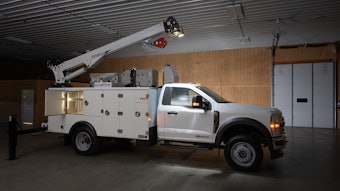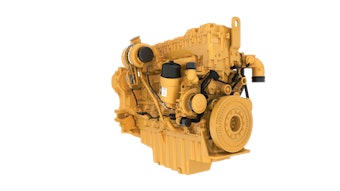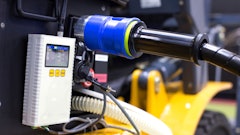
Make no mistake, diesel will remain the dominant power choice for vocational trucks for the foreseeable future. Diesel engines offer many advantages for working on constructions sites, such as high torque rise at low engine speeds and fuel availability. But the price of diesel fuel and complexity of aftertreatment systems mean other options may now be more viable. They deserve a look to see if an alternative powertrain option makes sense for your applications.
Gasoline Shaves Cost and Weight
Ford’s gasoline-powered engine offering for the Class 6 to 7 truck market is a 6.8-liter V10, which is available in the F-650/F-750. It allows a lower cost of entry with a vehicle MSRP that is a little over $11,000 below the diesel option.
This price differential will only widen as further emissions laws emerge. “That equates to a lot of money for some customers in certain applications,” says Todd Kaufman, F-Series Chassis Cab marketing manager, Ford Trucks.
While diesel trucks are slightly more fuel efficient, the cost equation is very favorable in applications where the trucks simply do not rack up many miles. For instance, consider a municipal fleet. “That truck may live in that city for 20 years and accumulate 50,000 miles,” says Kaufman.
The price difference of the fuel can also partially offset the difference in fuel economy. Gasoline costs a little less than diesel, but the engine will burn a little more of it. “We have found the margin between them has been as close as 13%,” says Kaufman. “It depends on where you are operating and what the climate is, but we have seen some customers who are getting within 1 or 2 mpg of what their diesel is doing.”
Modern gasoline engines are much more fuel efficient than older designs. In the case of the Ford 6.8-liter gasoline engine, it features a three-valve head and state-of-the-art technology.
“Both [gasoline and diesel] offer similar startability. However, the diesel engine has its torque rise at very low engine rpm,” says Kaufman. “That is the best situation you can have for pulling. A gasoline engine builds its torque and horsepower at a higher rpm. However, today’s automatic transmissions compensate for that. They can give you incredible startability in both low gear and reverse on a gasoline engine. Even under massive loads, they still have outstanding startability and gradeability.”
The 6.8-liter gasoline engine features a cast iron engine block with aluminum cylinder heads and pumps out 362 hp and 457 lbs.-ft. of torque. This compares to the standard Cummins ISB 6.7L turbo diesel, which comes in 11 power and torque ratings ranging from 200 to 360 hp and 520 to 800 lbs.-ft. of torque.
“The diesel engine is going to have a substantially higher compression ratio. This means a heavier engine is required because you need stronger construction, where the lower compression ratio on the gasoline engine allows for the use of lighter materials,” says Kaufman.
Consider the F-650/F-750 gasoline vs. the diesel version. “Depending upon the configuration, the difference is 400 or 500 lbs.,” says Kaufman. The difference is in both the weight of the engine and the aftertreatment devices. “The aftertreatment has become very heavy.” With the gasoline version, you don’t have any of that.
Maintenance costs are another key consideration. Ford conducted a study of gasoline vs. diesel in its F-650/750 trucks and came to a surprising conclusion. “The gasoline version is exactly one half the price of maintenance relative to the diesel over 100,000 miles,” says Kaufman. This considers all maintenance. “It is what I would call book maintenance. It is what our engineers suggest.”
Gasoline is also a lot quieter than diesel. “There are advantages of gasoline in certain applications because it is quiet,” says Kaufman. “You may bring a truck into a neighborhood at different hours.”
The gasoline-powered F-650/750 has a power-takeoff (PTO) provision with the six-speed TorqShift transmission. “In next year’s release on the medium-duty, we will have live-drive PTO capability on the gasoline version, which we currently do not have,” says Kaufman. “The PTO operates any time the engine is running regardless of what else it is doing.”
For the Long Haul
There was a time 15 or 20 years ago when diesel engines enjoyed a durability advantage over their gasoline counterparts. “But gasoline engines today regularly go into the 200,000-mile range,” says Kaufman.
Still, you need to make sure you are comparing apples to apples. Gasoline engines and some diesel engines use a parent bore design. Unlike sleeved engines at the upper end of the diesel range, these parent bore engines have a finite life. “They are very comparable,” says Kaufman. “They will both live into the couple hundred thousand mile range without requiring any type of major service. When it does come time for replacement, you can replace the entire gasoline engine at half the price of the diesel.”
Market acceptance for the gasoline option continues to grow. “We have seen the volume on our gasoline engines double year-over-year since the release,” says Kaufman. “We expect that to continue for a while.”
But it is difficult to predict total market potential. There is still a perception in the marketplace that a gasoline engine can’t do the work. “I cannot tell you how many people have told me that they did not realize it was this good until after they got it,” says Kaufman. It will take time for the perceptions to line up with current realities.
Natural Gas Cuts Fuel Costs
If readily available in your territory, the use of natural gas can result in significant fuel cost savings. While diesel fuel prices continue to climb, natural gas prices remain relatively stable and considerably less expensive.
“The main reason fleets are adopting natural gas is because of the fuel cost delta between natural gas fuel and diesel,” says Greg Treinen, segment manager, natural gas, Freightliner Trucks. “The cost difference between CNG and diesel fuel can be in the $1.50 to $2 per diesel gallon equivalent (DGE) range.”
What Contractors Need to Know About CNG and LNG
Another reason some companies adopt natural gas is the “green” factor. “With natural gas fuel emitting less greenhouse gas than diesel, many fleets that want to operate in a green manner are pursuing natural gas,” says Treinen. “Not only are fleets interested in natural gas for environmental reasons, but in some cases these fleet’s customers are interested, as well. In fact, some fleets have gained business because they run natural gas-fueled trucks.
“Another advantage to running with natural gas is the quietness of the engines,” says Treinen, “which in the case of the Cummins Westport ISL G is 10 dB quieter than its diesel counterpart.”
Still, there are drawbacks to consider. “Natural gas trucks require tanks that take up more space on the chassis — 24 additional inches behind the cab (if spec’d with Freightliner factory-installed CNG tanks),” says Treinen. “CNG tanks are much heavier than diesel tanks, as well — a several hundred pound weight increase, depending upon how much fuel capacity is required.”
Fuel infrastructure can also prove challenging. “Some areas of the country have really begun to build up CNG infrastructure. Even then, the fleet needs to make sure those locations make sense for their business,” says Treinen. “Another potential drawback could include the high incremental cost of a natural gas truck. But if the truck runs high miles or consumes a lot of fuel, the payback period could result in a lower real cost of ownership throughout the life of the vehicle.”
Freightliner offers natural gas solutions on its M2 112, 114SD and Cascadia models. (Video: Freightliner 114SD Natural Gas Truck Walk Around) While it has deployed natural gas trucks and tractors in almost every application, the best applications have proven to be those where the truck runs 80,000 or more miles a year or consumes 10,000 to 15,000 gal. of fuel per year. The company offers a natural gas calculator on its website (freightlinergreen.com/calculator) that can help you determine the potential fuel cost savings.
Also consider the maintenance of a natural gas engine. “There are some differences in maintenance and service of an ISL G engine compared to its diesel counterpart,” says Treinen. “Engine oil and filter change intervals are different, and the ISL G requires spark plug changes every 45,000 miles. The fuel filter also needs to be changed. There is no DPF or SCR, so aftertreatment maintenance is not required. Otherwise, the vehicles operate similar to diesel units.” However, if a fleet maintains its own trucks, there are shop upgrades that may be required.
In terms of medium-duty offerings, the Ford F-650/F-750 can easily be set up for natural gas. The 6.8-liter V10 is available with a gaseous engine prep package for CNG or LPG conversion. This includes the required hardened valve seats.
“There are a lot of benefits to going to CNG and propane,” says Kaufman. “They have slightly different subtle properties vs. gasoline. However, the octane level is extremely high. We work with our Qualified Vehicle Modifiers (QVMs) to ensure that it is a seamless transition. We want to make sure they calibrate it so the experience to the operator is identical to gasoline. They don’t even know the difference. I have a dump truck that is a CNG conversion. If I did not tell you it was CNG, you would not know it from a performance perspective.”





























